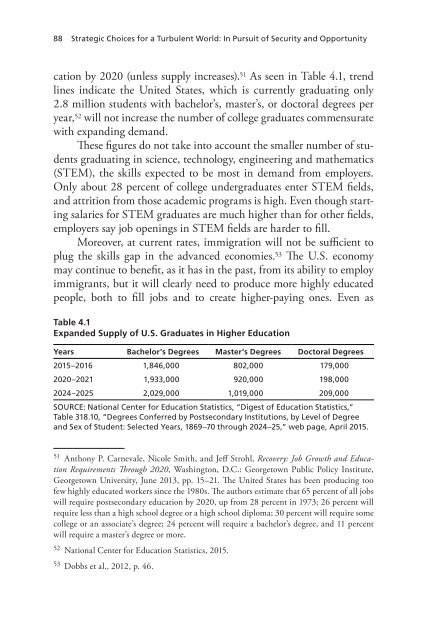Create successful ePaper yourself
Turn your PDF publications into a flip-book with our unique Google optimized e-Paper software.
88 Strategic Choices for a Turbulent World: In Pursuit of Security and Opportunity<br />
cation by 2020 (unless supply increases). 51 As seen in Table 4.1, trend<br />
lines indicate the United States, which is currently graduating only<br />
2.8 million students with bachelor’s, master’s, or doctoral degrees per<br />
year, 52 will not increase the number of college graduates commensurate<br />
with expanding demand.<br />
These figures do not take into account the smaller number of students<br />
graduating in science, technology, engineering and mathematics<br />
(STEM), the skills expected to be most in demand from employers.<br />
Only about 28 percent of college undergraduates enter STEM fields,<br />
and attrition from those academic programs is high. Even though starting<br />
salaries for STEM graduates are much higher than for other fields,<br />
employers say job openings in STEM fields are harder to fill.<br />
Moreover, at current rates, immigration will not be sufficient to<br />
plug the skills gap in the advanced economies. 53 The U.S. economy<br />
may continue to benefit, as it has in the past, from its ability to employ<br />
immigrants, but it will clearly need to produce more highly educated<br />
people, both to fill jobs and to create higher-paying ones. Even as<br />
Table 4.1<br />
Expanded Supply of U.S. Graduates in Higher Education<br />
Years Bachelor’s Degrees Master’s Degrees Doctoral Degrees<br />
2015–2016 1,846,000 802,000 179,000<br />
2020–2021 1,933,000 920,000 198,000<br />
2024–2025 2,029,000 1,019,000 209,000<br />
SOURCE: National Center for Education Statistics, “Digest of Education Statistics,”<br />
Table 318.10, “Degrees Conferred by Postsecondary Institutions, by Level of Degree<br />
and Sex of Student: Selected Years, 1869–70 through 2024–25,” web page, April 2015.<br />
51 Anthony P. Carnevale, Nicole Smith, and Jeff Strohl, Recovery: Job Growth and Education<br />
Requirements Through 2020, Washington, D.C.: Georgetown Public Policy Institute,<br />
Georgetown University, June 2013, pp. 15–21. The United States has been producing too<br />
few highly educated workers since the 1980s. The authors estimate that 65 percent of all jobs<br />
will require postsecondary education by 2020, up from 28 percent in 1973; 26 percent will<br />
require less than a high school degree or a high school diploma; 30 percent will require some<br />
college or an associate’s degree; 24 percent will require a bachelor’s degree, and 11 percent<br />
will require a master’s degree or more.<br />
52 National Center for Education Statistics, 2015.<br />
53 Dobbs et al., 2012, p. 46.




